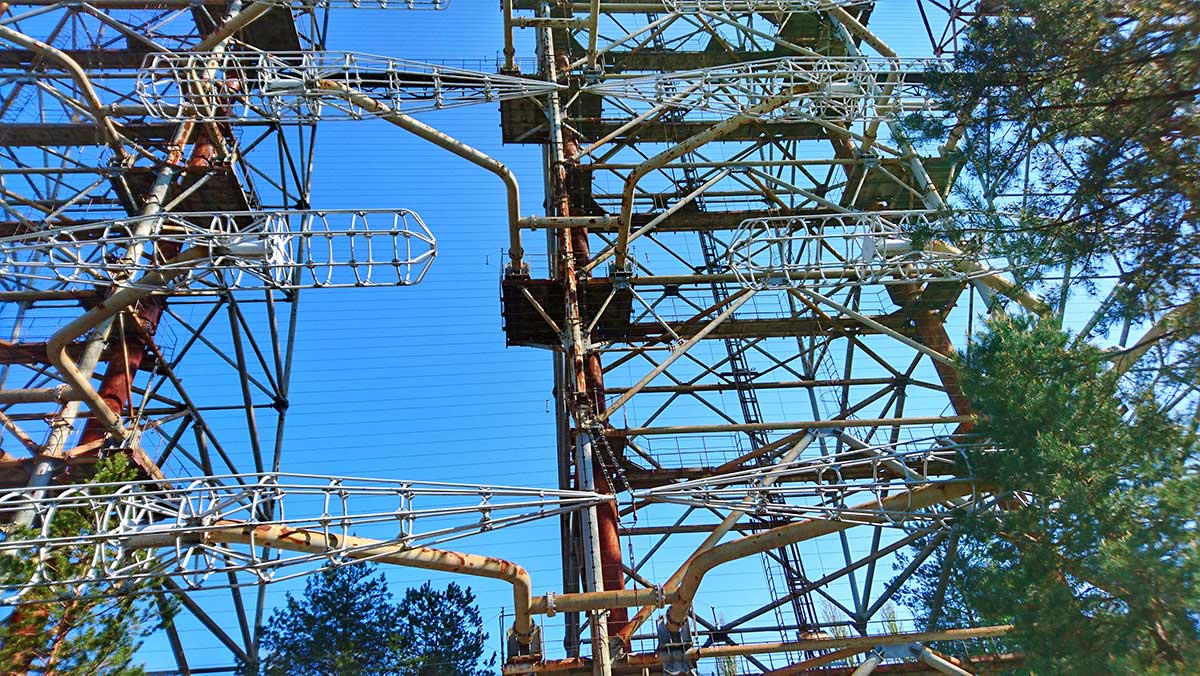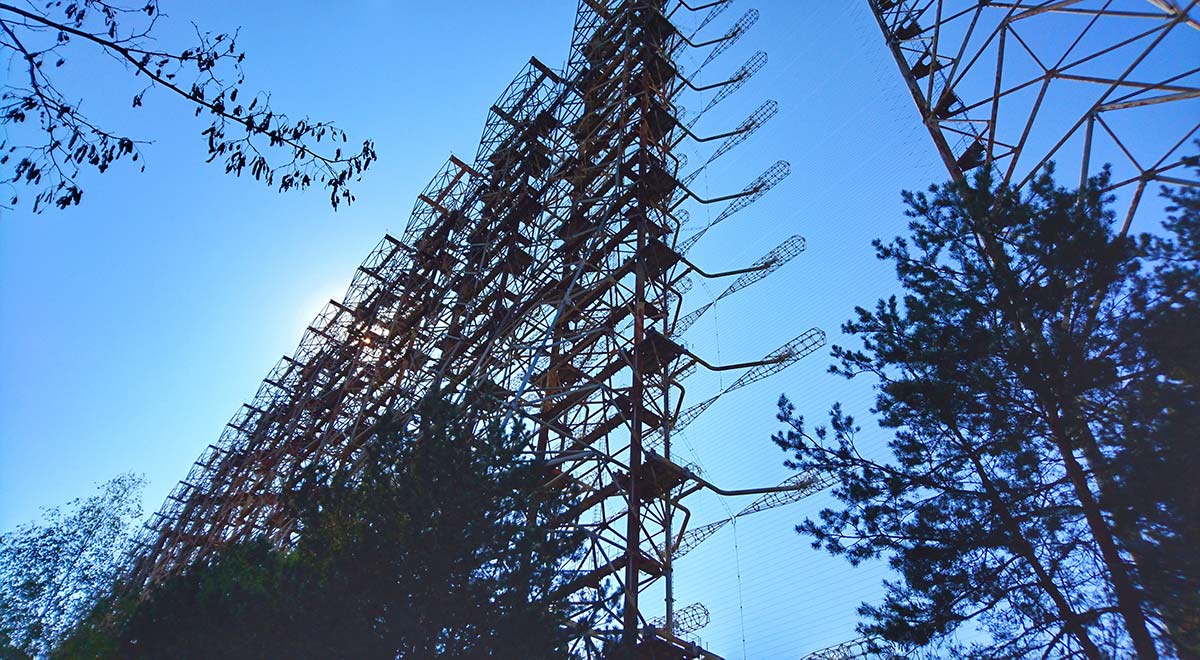In 1976, a strange signal was picked up by amateur radio enthusiasts around the world. The signal sounded like sharp, repetitive tapping noises at a frequency of 10Hz and seemed to be coming from the Soviet Union, earning it the nickname Russian Woodpecker. Triangulation by the amateur radio operators, and later by NATO, suggested that the noise was coming from a location between Minsk and Kyiv, probably near the town of Chernobyl in present day Ukraine. There were suggestions from some quarters that the Soviet Union was carrying out brainwashing or weather modification experiments but it was deemed most likely to be an over-the-horizon radar system used as part of the early-warning radar network for missile defence. This was the Duga-1 radar.

At the end of World War II, The United States of America and the Soviet Union emerged as the two dominant world powers, and both sought to extend their influence across the globe. This led to the Cold War. One of the primary causes of the Cold War was the ideological differences between the two superpowers. The United States was a capitalist democracy, while the Soviet Union was a communist state. These two systems of government were fundamentally opposed to each other, and both sides saw the other as a threat to their way of life.
The Cold War led to the arms race as both the United States and the Soviet Union sought to build more powerful weapons. This included nuclear armaments and forms of military technology, such as missiles, bombers and submarines. Both sides invested heavily in research and development. Vast sums were spent on military programs. The arms race was fuelled by a number of factors, including fear, mistrust and ideology. Both sides believed that they needed to be prepared for a potential war and sought to demonstrate its military strength and technological prowess.

One of the features of the arms race was the development of the intercontinental ballistic missile. The first ICBMs were developed in the 1950s and were designed to deliver nuclear warheads over great distances. These missiles were capable of travelling at speeds of over 24,000 kph (15,000 mph) and could reach targets on the other side of the world within minutes, making it possible for either side to launch a devastating nuclear strike against the other.
Both sides began developing anti-ballistic missile systems. Early warning radar was a key component and worked by using a network of radar stations located around the world to detect and track ballistic missiles. These stations were equipped with powerful radar antennas that could detect the heat signatures and other characteristics of missiles in flight. The data collected by the radar stations was then analysed by sophisticated computer systems, which could calculate the trajectory and likely target of the missiles. This information was then relayed to military commanders, who could decide whether to launch a counter-attack or take other defensive measures.

In the 1960s, the Soviets developed early warning satellites but the technology was not deemed accurate enough and so development began on an over-the-horizon radar. OTHR is a type of radar system that is capable of detecting targets beyond the horizon. Traditional radar systems are limited by the curvature of the Earth, which prevents them from detecting targets that are over the horizon. OTHR systems work by bouncing radio waves off the ionosphere, a layer of the Earth’s atmosphere. These radio waves are then reflected back to Earth and picked up by the radar system. OTHR systems are able to detect targets at much greater distances than traditional radar systems which makes them particularly useful for surveillance and monitoring purposes.

The first experimental system built by the Soviets was called Duga and was located near the city of Mykolaiv in the Ukrainainian SSR. It was capable of picking up rocket launches from the Baikonur Cosmodrome 2,500 kilometres (1,600 miles) away. It was later expanded to track launches from the far east of the Soviet Union and submarines in the Pacific Ocean. With the test successful, work began on the first operational Duga radar.

The site chosen for the radar was near the town of Chernobyl, also in the Ukraininian SSR and close to the border with the Belorussian SSR. The area was also the location of the Vladimir Ilyich Lenin Nuclear Power Plant, more commonly known as the Chernobyl Nuclear Power Plant. The nearby city of Pripyat was constructed as an atomograd, the term used by the USSR to describe a purpose built community to house workers associated with a Nuclear Power Plant. Because Pripyat was regarded as a closed city, access was restricted and therefore the area was deemed a secure location for the Duga radar.

Duga-1 consisted of a transmitter located 12 kilometres north-west of Chernobyl and a receiver located 50 kilometres (31 mi) northeast of Chernobyl. The transmitter used a large array of antennas, measuring 700 metres (2,300 ft) in length and 150 metres (490 ft) in height, to send powerful pulses of radio waves into the ionosphere, while the receiver listened for the echoes of these waves bouncing back from potential targets. By analysing the time delay between the transmitted and received signals, the system could determine the location of a potential missile launch.
Duga-1 earned the name the Russian Woodpecker from amateur radio enthusiasts because of the repetitive tapping noises. The tapping was caused by the radar’s frequency hopping between different frequencies in order to avoid interference and jamming. The signal often caused interference around the world, disrupting radio broadcasts, commercial aviation communications and utility transmissions. A number of countries complained but the Soviet Union denied any knowledge of the signal. It became so bad that some communications receivers began including Woodpecker Blankers in their circuit designs. Amateur radio enthusiasts tried to jam the signal, creating a group called the Russian Woodpecker Hunting Club. NATO gave it the reporting name of STEEL YARD but STEEL WORK was also used.

A second radar, Duga-2, was constructed near Komsomolsk-on-Amur in Khabarovsk Krai in the far east of the Soviet Union. That location was chosen because like Pripyat, it too was a closed city. It was a major industrial centre and home to large aircraft manufacturing and ship building plants.
In the early hours of April 26 1986, an accident occurred at the Chernobyl Nuclear Power Plant resulting in a massive release of radioactive material into the atmosphere. The city of Pripyat, which was home to around 50,000 people, was evacuated on the morning of April 27, 1986, about 36 hours after the explosion. On 2 May, a Soviet government commission ordered an exclusion zone be created in an area of a 30 kilometre (19 miles) radius from the damaged Reactor 4. This included the Duga-1 radar array. The Chernobyl Nuclear Exclusion Zone was later extended to 2,600 km2 (1,000 sq miles) and nearly 100,000 people were evacuated. Today, public access and habitation are restricted inside the Exclusion Zone.
Following the Chernobyl disaster, the Russian Woodpecker signals became less frequent. Tensions between the United States and the Soviet Union began to ease and in December 1989, the signal stopped for good. The Soviet Union was dissolved on 26 December 1991. Duga-2, in the far east of Russia was dismantled but because Duga-1 was located in the Chernobyl Nuclear Exclusion Zone, the newly formed Ukrainian government had no choice but to leave it standing due to potential radioactive contamination risks.

Duga-1 was left abandoned and all access was banned. As the number of tourists wishing to visit the Chernobyl Nuclear Exclusion Zone increased, the government decided to give access to Duga-1 to those on official tours. The site was opened to tourists in October 2013.
Duga-1 has appeared in a number of video games, notably Chernobylite, the S.T.A.L.K.E.R. series, Call of Duty: Black Ops and Call of Duty: Warzone. It was also the focus of the 2015 documentary film, The Russian Woodpecker, by Chad Gracia which proposes a conspiracy theory that the Chernobyl disaster was engineered to cover up failures in the radar’s design.


Pingback: What You Need to Know About Visiting the Chernobyl Nuclear Exclusion Zone
Pingback: Inside Chernobyl - Everything You Need To Know About Visiting the Nuclear Exclusion Zone 🇺🇦